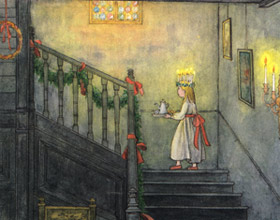Santa Lucia’s Day

Illustration by Satomi Ichikawa in Merry Christmas – Children at Christmastime around the world (Wm.Heinemann, 1983)
In Helsingin Sanomat is an article about the Saint Lucia parade held last night, December 13th, in Helsinki.
As the doors of the Helsinki Cathedral opened at six on Tuesday evening, this year’s Lucia Marianne Ekqvist, 22, emerged out of the darkness and began descending the steps of the Cathedral. The white-clad figure with a crown of candles led the annual Helsinki Lucia Parade […] Thousands of citizens followed the parade through downtown Helsinki. The tradition is particularly popular among Swedish-speaking Finns, who arrange an election of Lucia every year. She traditionally wears a white gown, a red sash, and a crown of lingonberry twigs and candles, and carries a sheaf of wheat. Read more…
I’m not very familiar with this Swedish holiday, so decided to read up on it. Virtual Finland’s Christmas** has some lovely images of Santa Lucia – just click on the thumbnail image second from the left.
Santa Lucia’s day is observed on December 13. This observance originally came to Finland from Sweden, where the celebration of a maiden dressed in white and wearing a crown of lighted candles became linked to Christmas only because the saint’s day falls when it does. Nevertheless, the selection of a Lucia and the procession that follows have become a tradition in many a Finnish town. Lucia was originally a Sicilian maid who defied her father by refusing to marry the man he had chosen for her. Lucia suffered a martyr’s death. In Helsinki, the beautiful pre-Christmas procession in honour of Lucia features Lucia herself with her crown of candles and white dress, surrounded by her attendants, symbolizing purity, whilst the flames of the candles denote her martyrdom.
Wikipedia has an excellent page on Saint Lucia with its origins, history and traditions. Lucia is the only saint celebrated by the Lutheran Swedes, Finns, Danes, and Norwegians, in celebrations that retain many pre-Christian elements of a midwinter light festival. Her feast day in the West is December 13, by the unreformed Julian calendar the longest night of the year.
Lucia also means light, so this is a festival of lights in the dark northern countries. I find it fascinating how the many religious and pagan traditions meld and transform over time into our modern day celebrations. Countries with a strong Catholic church have their own traditions around this day, such as in Italy, Germany and Slovakia.
I have a children’s book Merry Christmas – Children at Christmastime around the world, illustrated beautifully by Satomi Ichikawa, with text by Robina Beckles Willson (Wm.Heinemann, 1983). There’s a lovely section on Sweden covering Saint Lucia from which I’ve summarized this story. The tradition of wearing a crown of candles came from the first Lucia, who carried food in her free hands in the dark to the persecuted Christians hiding in caves. In Swedish families, the children prepare special buns and ginger snaps the day before. Very early the next morning the youngest daughter puts on a long white dress with a red sash and a crown of evergreens with candles. She carries a tray of coffee and buns to her family while they are still in bed.
A belated Happy Saint Lucia’s Day to all!
** expired and removed link
December 14, 2005 in Books, Culture, Finland, Estonia & Finno-Ugric by Marja-Leena
Thank you for the information.
I heard about the Lucia day before, and this year I happily came to Helsinki to see all the event live. It is truly magical, almost spellbinding… Now I am collecting materials about the Lucia Day tradition.
Hello Anton,
I wish I could have been in Helsinki to see the St. Lucia event – you make it sound wonderful! Thank you for writing in.